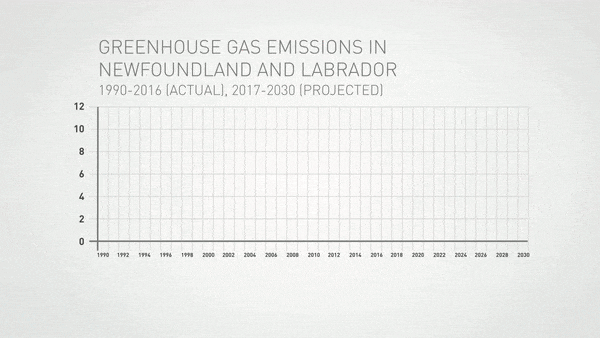What's the plan? Explaining the N.L. climate change strategy
In the fight to save the planet, this province has a game plan. But some pages are missing

The warnings about climate change have been building for years, but it feels like people are finally starting to listen.
Maybe it's the shocking details of the latest scientific reports, like the one about how Canada is warming twice as fast as the global average. Maybe it's because policies linked to climate change are having a bigger impact on how we live, like the carbon tax Canadians now pay at the gas pumps.
The Newfoundland and Labrador government recently released its own climate change report, which details how much greenhouse gas the province produces, our targets for reducing emissions, and how we intend to make it happen. It also offers a glimpse of the consequences of continuing on our present course.
This chart, and the ones to follow, are adapted from that report, titled The Way Forward on Climate Change. In just 50 years, from 2000 to 2050, temperatures in Newfoundland are projected to rise by two and a half to three degrees in summer, three and a half to five degrees in winter. In Labrador, warming will be even more severe. By mid-century, winters in Nain will be more than seven degrees hotter.

The actions of one small province will not have much influence on global warming, but they may influence the people and governments of other, larger nations, as they make crucial decisions about their own climate policies. Besides, when have Newfoundlanders and Labradorians not shouldered their share of the work?
Read on to learn more about our climate plan, or click the video below.
The baseline: how much CO2 we produce
In 2016, Newfoundland and Labrador produced 10.75 million tonnes of carbon dioxide and other greenhouse gases. While that isn't much in absolute terms, our per-capita emissions are higher than the Canadian average.
Our reduction targets use the year 1990 as a baseline, when emissions were around 9.3 million tonnes. In 2007, the province committed to cutting a million tonnes from that baseline by 2020 — a commitment we will badly miss. Our next target is to cut more than three million tonnes by 2030.
These targets are indicated on the graph below. The red line represents our greenhouse gas emissions to date, and a projection of would happen if we took no new steps to reduce emissions. As you can see, meeting our reduction targets would mean a big change in course.

What's the plan?
So how do we make these cuts? The Way Forward on Climate Change says up front, "There is no easy, single measure that will achieve the GHG reductions needed." Instead, the report outlines a range of strategies, touching almost every corner of government planning and citizen life.
The biggest component of our climate strategy is what the report calls a carbon program. It's all about attaching a cost to the burning of fossil fuels, since that's where most greenhouse gas emissions come from.
The vast majority of this province's burning come from two sources: transportation and large industry. Transportation accounts for 34 per cent of greenhouse gas emissions, including all our cars, trucks, boats and plane trips. Large industry is just slightly ahead at 35 per cent, including offshore oil but also mining, oil refining and pulp and paper. In these areas, the carbon program is already having an impact.

We experience it every time we gas up our cars. Today, the carbon tax adds about 4.4 cents per litre of gasoline, but it's set to rise every year. And higher gas prices can eventually lead to higher prices on all sorts of goods and services.
For large industry, government has set specific and escalating targets for big polluters to reduce their emissions at the source. If that doesn't happen, companies will have to pay, in the form of emissions-reduction credits.
Together, these moves are projected to reduce emissions by 650,000 tonnes by 2030. That's a significant reduction, but it's a long way from our goal of cutting three million tonnes.
Other ideas
So, what else are we doing? The climate report touches on a host other other initiatives, including retrofitting homes and buildings, investing in green technology and infrastructure, getting cleaner vehicles on the road, smarter urban planning, and raising public awareness of environmental issues.
But it's harder to predict the impact of these actions, and the climate report doesn't try to estimate their effects. It does however, offer other strategies for mitigating the damage that climate change will likely cause. Everything from community infrastructure, health-care services, even local agriculture will need to be considered with a more volatile climate in mind.
There is one other major component of the province's climate change strategy: Muskrat Falls. Today, 14 per cent of our carbon emissions from generating electricity, mainly at the Holyrood Generating Station. When Muskrat Falls comes online and the Holyrood station is (theoretically) shut down, almost all electricity in the province will come from renewable sources. That alone could reduce emissions by almost a million and a half tonnes.

On the other hand, the report makes no mention of the government's plan to double offshore oil production in the next 10 years. This could significantly add to emissions, both on the province's and on Canada's balance sheets. Critics are questioning whether we can simultaneously cut emissions and ramp up oil production, but the government has made clear it's committed to the plan.
Enormous challenges
For those of you doing the math, you may have realized our current plan likely leaves us well short of our climate goals. The government's climate report acknowledges that, but says options for making big, sweeping reductions are limited. Electricity generation will soon be free of emissions, so there's no more savings to had there.
"In addition, the province's small and dispersed population limits opportunities for public transit, and there is no access to natural gas," the report says.
We've set ambitious goals for ourselves, and our situation calls for nothing less. But there's a big gap between those goals and of knowledge of how to achieve them. "The scale of the required long-term reduction in GHG emissions is enormous," the climate report admits. It says that some of our planned reductions "will require the development and application of technologies that do not exist today."
In other words, we don't have all the answers yet. But we may finally be asking the right questions.


